Explainer: Where did Zika virus come from and why is it a problem in Brazil?
Written by Amy Y. Vittor, University of Florida From October 2015 to January 2016, there were almost 4,000 cases of babies born with microcephaly in Brazil.…
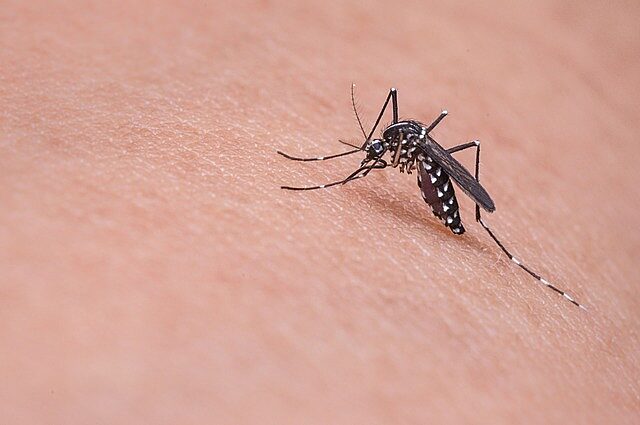
Update your location to show providers, locations, and services closest to you.
Insect bites and stings can cause an immediate skin reaction. The bite from fire ants and the sting from bees, wasps, and hornets are most often painful. Bites caused by mosquitoes, fleas, and mites are more likely to cause itching than pain.
Insect and spider bites cause more deaths from venom reactions than bites from snakes. Most deaths from insect bites are due to allergic reaction to the venom, rather than the toxins in the venom itself.
Bee sting; Bed bug bite; Bites - insects, bees, and spiders; Black widow spider bite; Brown recluse bite; Flea bite; Honey bee or hornet sting; Lice bites; Mite bite; Scorpion bite; Spider bite; Wasp sting; Yellow jacket sting
In most cases, bites and stings can be easily treated at home.
Some people have extreme reactions that require immediate treatment to prevent death.
Certain spider bites, such as the black widow or brown recluse, can cause serious illness or death. Most spider bites are harmless. If possible, bring the insect or spider that bit you with you when you go for treatment so it can be identified.
Symptoms depend on the type of bite or sting. They may include:
Some people have severe, life-threatening reactions to bee stings or insect bites. This is called anaphylactic shock. This condition can occur very quickly and lead to rapid death if not treated quickly.
Symptoms of anaphylaxis can occur quickly and affect the whole body. They include:
For severe reactions, first check the person's airways and breathing. If necessary, call 911 or the local emergency number and begin rescue breathing and CPR. Then, follow these steps:
General steps for most bites and stings:
Remove the stinger by scraping the back of a credit card or other straight-edged object across the stinger. Do not use tweezers -- these may squeeze the venom sac and increase the amount of venom released.
Wash the site thoroughly with soap and water. Then, follow these steps:
Use the following precautions:
Call 911 or your local emergency number if someone with a sting has the following symptoms:
If you had a severe, bodywide reaction to a bee sting, your provider should send you to an allergist for skin testing and therapy. You should receive an emergency kit to carry with you wherever you go.
You can help prevent insect bites and stings by doing the following:








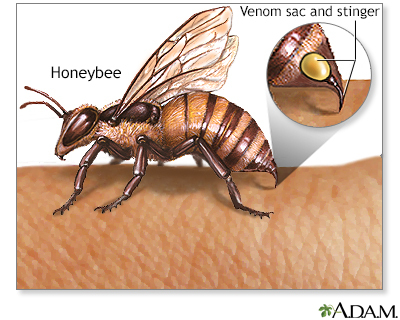
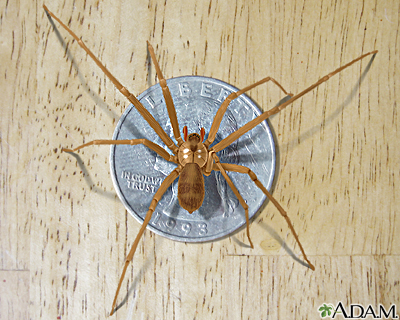
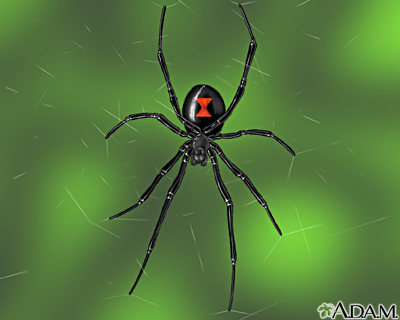
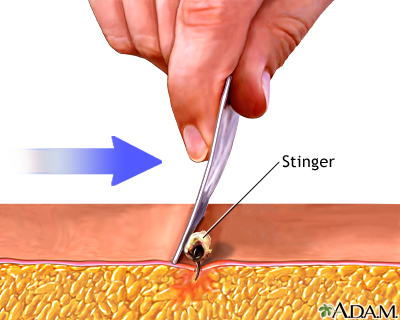


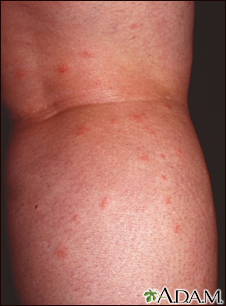


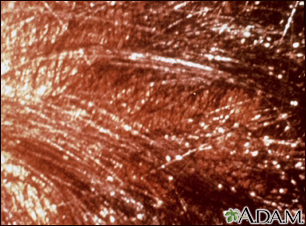




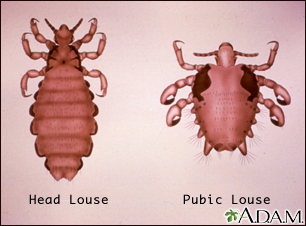

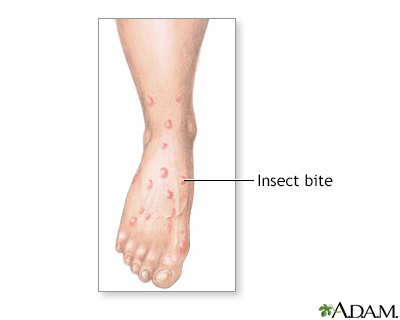
Boyer LV, Binford GJ, Degan JA. Spider bites. In: Auerbach PS, Cushing TA, Harris NS, eds. Auerbach's Wilderness Medicine. 7th ed. Philadelphia, PA: Elsevier; 2017:chap 43.
Ennik F. Deaths from bites and stings of venomous animals. West J Med. 1980;133(6):463-468. www.ncbi.nlm.nih.gov/pmc/articles/PMC1272387/.
Otten EJ. Venomous animal injuries. In: Walls RM, Hockberger RS, Gausche-Hill M, eds. Rosen's Emergency Medicine: Concepts and Clinical Practice. 9th ed. Philadelphia, PA: Elsevier; 2018:chap 55.
Patterson JW. Arthropod-induced diseases. In: Patterson JW, ed. Weedon's Skin Pathology. 5th ed. Philadelphia, PA: Elsevier Limited; 2021:chap 31.
Seifert SA, Dart R, White J. Envenomation, bites, and stings. In: Goldman L, Schafer AI, eds. Goldman-Cecil Medicine. 26th ed. Philadelphia, PA: Elsevier; 2020:chap 104.
Suchard JR. Scorpion envenomation. In: Auerbach PS, Cushing TA, Harris NS, eds. Auerbach's Wilderness Medicine. 7th ed. Philadelphia, PA: Elsevier; 2017:chap 44.
Written by Amy Y. Vittor, University of Florida From October 2015 to January 2016, there were almost 4,000 cases of babies born with microcephaly in Brazil.…
